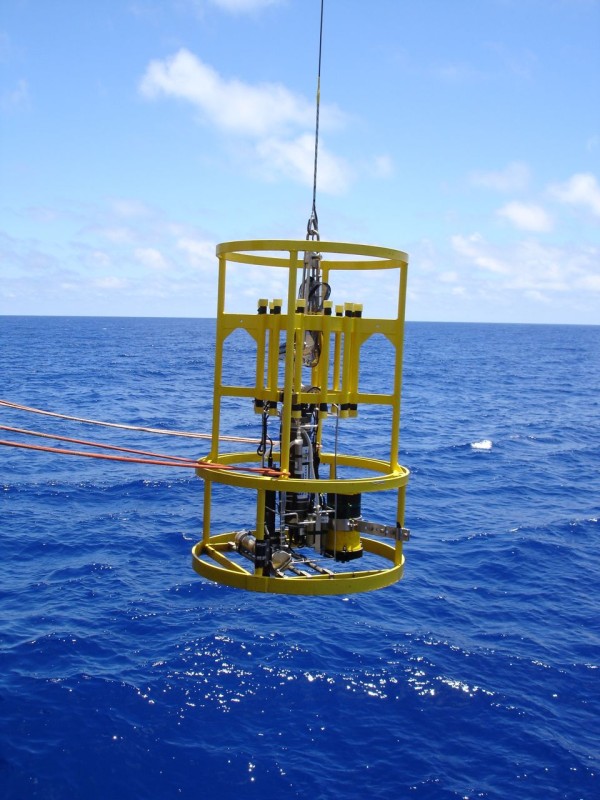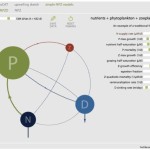So you are on research cruise. And in your state of unadulterated science glee you decide that you want to share with the world your knowledge of this awesome oceanographic research instrument called “the CTD.” However, in the immortal words of Kanye West, “I’m really happy for you and Imma let you finish, but…” a lot of you have been doing it wrong.
First off, it’s probably not your fault that you have been doing it wrong. On behalf of the physical oceanography community, I’m going to start off with an apology. We have been unintentionally misleading you. Below is a picture of what is commonly called “the CTD.” That is the colloquial name for what is actually several types of equipment all mounted on one common platform. “Deploy the CTD!” is just a lot more convenient than “deploy the rosette containing the CTD, oxygen sensor, fluorometer, scatterometer, and 24 Niskin bottles!” And nearly all these photos of “the CTD” have one thing in common, you can barely see the real CTD.

What you mostly see in a photo of “the CTD” are giant grey tubes arranged in a circle on a metal frame. The tubes are Niskin Bottles, which are used to collect samples of seawater as the frame is lowered to different depths. Some frames are so large that they have 36 bottles on them (fun fact: at my current place of employment they are built in the parking lot they are so big). Niskin bottles don’t actually measure anything, so they are technically not a “sensor.” But as you can see, the Niskin bottles take up a lot of real estate. The instrument that is actually the CTD has to be placed underneath this ring of water sampling power. And that is why you can’t see the CTD in most photos.

So then what the hell is a CTD? The name CTD is an acronym for “conductivity, temperature and depth”, the three quantities which this instrument measures. The CTD does this with three different sensors: a thermistor, a conductivity sensor and a pressure sensor. These sensors do not sample or collect water, that is what the Niskin bottles are for. What the CTD does do is to measure these quantities “in situ”, in their original place. Even more specifically, as the instrument is lowered water is sucked into a tube by a small pump, passes these three sensors sampling at 24 times a second and is then immediately spit back out. The data are then relayed back to the shipboard computer through the steel cable that is used to raise and lower the entire frame. Profiles can take anywhere from 10 minutes to 10 hours depending on how deep you want to send your science package. Fun fact: standard CTD’s can’t go deeper than 5 kms. It’s not because pressure will crush the instrument, but rather a steel cable longer than 5 km is too heavy to safely be deployed from a ship!
Apparently, we oceanographers are not an imaginative bunch. Nearly all of us love to describe the CTD as “the workhorse of oceanography” (mostly because the “donkey of oceanography” just never quite caught on). But it really, really is a fantastic instrument that revolutionized oceanography. The CTD literally enables us to see inside the ocean. Conductivity, temperature and pressure are converted into other quantities such as salinity and density, that reveal the ocean’s vertical and horizontal structure (I talked about this in a previous post). Check out a beautiful cross-section of salinity across the Atlantic Ocean obtained with a CTD below. There are salty blobs and layers at different depths and distances. But this map only shows the big picture, at horizontal scales of 100’s of kilometers. There are even smaller layers within the ocean at scales as small as cm’s creating even more complex vertical and horizontal patterns. And we can see all this each time we plunk our venerable CTD into the sea.

Now that you have learned how to identify the CTD in its natural habitat, please help spread the word. The CTD is actually a specific instrument on that giant hunk of metal and plastic you just lowered into the abyss. It only measures three things, temperature, conductivity, and pressure. And the CTD sensor does not collect water to bring back to the surface. That is Niskin bottle’s job. But don’t worry, you can still yell “deploy the CTD” while at sea. Everyone oceanographer worth their salt is gonna know what you are talking about.
UPDATE: Thanks to an astute commenter with a keen knowledge of physics, I incorrectly described the physical location of the pressure sensor on the CTD. It is not located in the duct that seawater is pumped through. The pressure sensor is located outside this duct, usually someplace else on the pressure case. If it was located in the duct, the pressure that is measured might be slightly offset due to the Bernoulli effect. However, the CTD still pumps seawater past thermistor and through the cylindrical glass conductivity sensor, both located in the duct.






Coming from an mechanical engineering background, being a conservation-conscience diver and general geek, I could not help but notice this phrase, “small pump, passes these three sensors”, and wonder why would the pressure sensor be in the line of flowing water from a small pump. Is there an adjustment algorithm for the number that comes out of the hat?
Oops, that was a mistake. Seawater is pumped past the thermistor and through the conductivity sensor which is a glass tube. The pressure sensor is actually located elsewhere on the pressure case to avoid this problem. Thanks for catching that!
I’ve been alternately annoyed and amused that we’re careful to specify we’re measuring conductivity, not actually the salinity we’re really interested in, but we go right ahead and sloppily continue calling it the useful “depth” when we’re actually measuring pressure. One’s the actual raw measurement; one’s converted to the interesting variable.
One or the other, people!
(I supposed calling an “STD” wouldn’t go over well. But what’s wrong with CTP?)
Funny, coming from more of a coastal/shelf perspective we have quite a few bare Seabird CTD’s that we can (and likely have) strap onto almost any piece of gear going down. We have put them in optical IOP cages, on photo sleds, buoys, and more often than not just deployed them on a line to do profiles. We do have one small rosette cage with 2L niskin bottles that get’s used and one of the big rosette cages with the big niskin bottle mounts, but most of the coast to shelf-break work doesn’t call for that piece of gear.
Great summary.
Now that’s a science-oriented mind responding.
For Science!